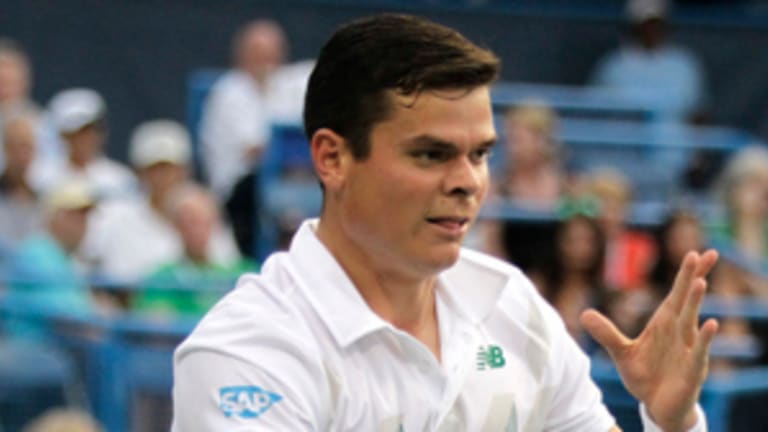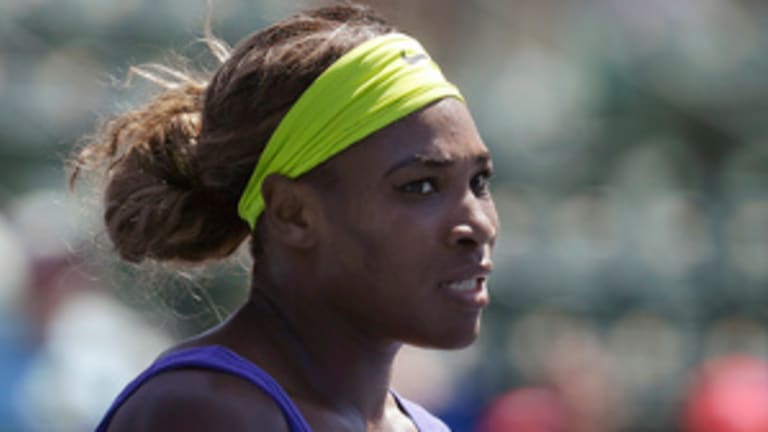“I think the number I have beside my name is not a coincidence, and I don’t think it would be a coincidence if it got lower.”
Those confident words were uttered on Sunday by Milos Raonic, who, at 23, has reached a career-high No. 6 in the world, and isn’t afraid to say he deserves to be there. By tennis’s polite standards, he sounded like a pro wrestler bellowing about his god-like status. Which was a bit surprising, considering that Raonic’s title in Washington, D.C., this weekend was his first in 11 months, and the first to come at a tournament larger than a 250, the lowest rung on tour.
Were his big words justified? On the one hand, Raonic’s recent results are the best he's ever had. After four years of ups and downs, starts and stops, he has begun to make himself into a reliable winner. He reached the quarters and semis of the last two majors, before losing to Novak Djokovic and Roger Federer. He followed that up by beating the players he was supposed to beat in D.C., without dropping a set to any of them. And as far as his ranking going “lower,” Raonic is probably just stating the obvious. He’s only 35 points behind No. 5 Tomas Berdych, who has been in decline of late.
Just as much as his results, what gives Raonic confidence is the fact that he feels like his game is on track, and that he's doing the right things to get better with coaches Ivan Ljubicic and Ricardo Piatti—he hasn't always felt that way. Last week, it was apparent that Raonic’s consistency, movement, and return—all three of them are weak points—had improved. Even his serve, already among the best in the game, was better. For the tournament, he won 52 of 53 service games, and 88 percent of first-serve points. You don’t have to do much else if you can serve like that.
Raonic has always been a process-oriented guy, someone who, whatever his results were at any given moment, hasn't lost his belief in what he can do in the long run. Much like his hero Pete Sampras, Raonic’s core of confidence can be traced back to his serve; he knows that this shot alone makes him difficult for any player to beat. Last year Federer chose Raonic as his most-likely-to-succeed among the next generation partly because Milos was the most organized and forward-thinking of them. Along with his two coaches, Raonic has had a personal PR flack for a couple of years now. That organization, that methodical dedication to moving forward and improving, has begun to pay dividends. As you can see by his words above, Raonic is more self-assured and ambitious than his robotically even-keel demeanor on court might lead you to believe. While that ambition is not necessarily endearing, it’s a useful quality to have.
But not all has gone according to plan. Along with his confident predictions for the future, last week Raonic expressed regret over how poorly he played in his Wimbledon semifinal loss to Federer. Raonic likely realized that what he hasn’t done so far is the one thing that many fans are waiting him for him to do—beat one of the Big Four on a big stage. At the majors, he has played Federer twice, Djokovic once, and Murray once, and has lost all 12 sets. And he has yet to win a Masters title.
As important as Raonic’s serve is, and as important as that shot remains in tennis, few ace machines have won major titles. The last one to win a Slam was Andy Roddick at the U.S. Open in 2003. And only one player who is taller than Raonic has ever won a major; Juan Martin del Potro, the 2009 Open champ, is 6’6”, Raonic is 6’5”. The Argentine is also a much more natural, all-around player than the Canadian.
Raonic’s ranking, as he says, will likely get lower, but will it get as low as he likes to think in the foreseeable future? He’s only four spots behind Rafael Nadal, and five spots behind Novak Djokovic, but that’s a difference of 8,000 ranking points. And while Raonic may seem to have time on his side, he's just four years younger than Djokovic, and five years younger than Nadal. Raonic has done a lot in the last couple of months, but he has a long way to go before he makes the achievement gap with Rafa and Nole as narrow as the age gap.

